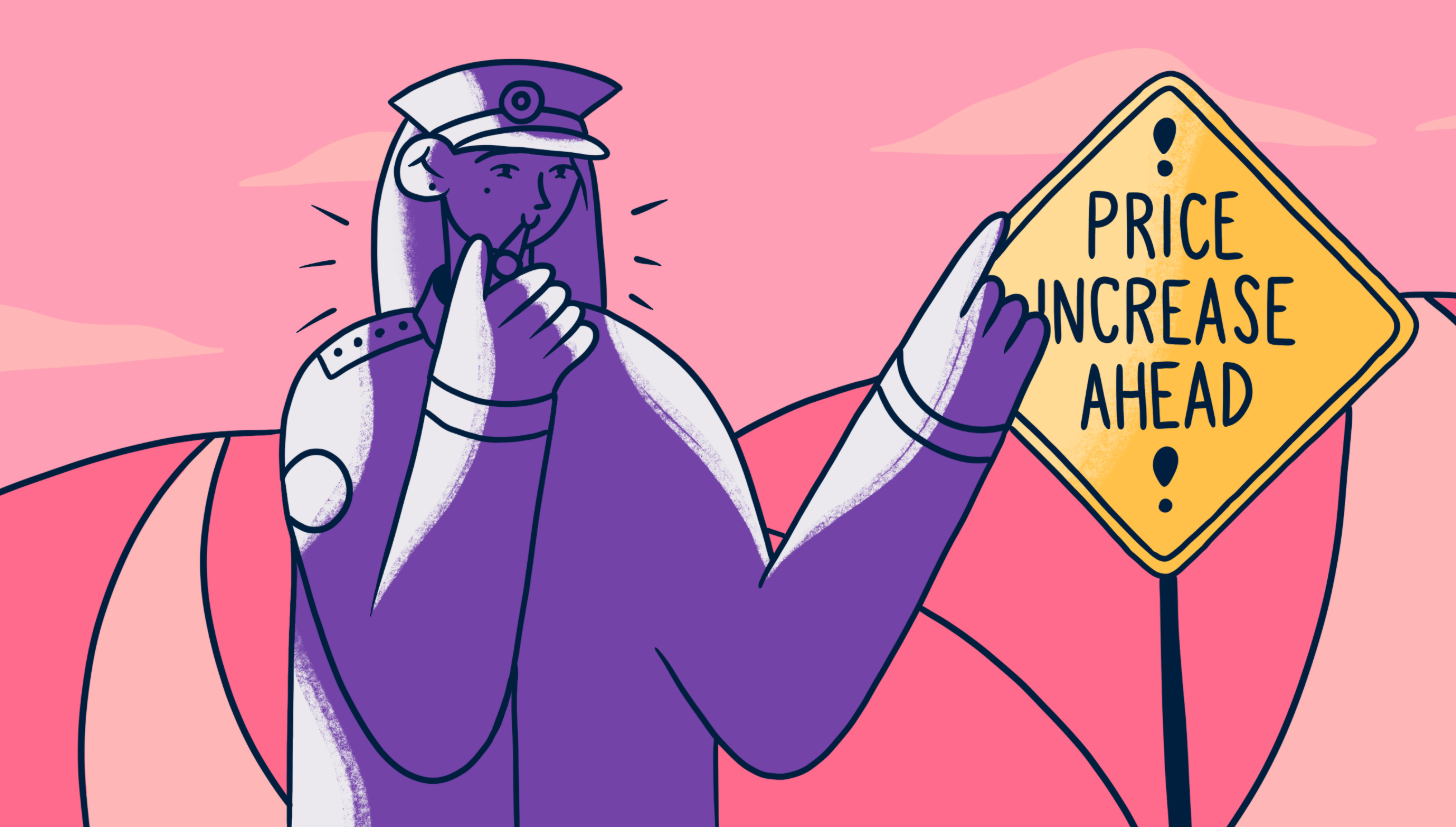Many small and medium-sized businesses are finding it challenging to handle the current economic conditions. Rising inflation and higher interest rates are putting pressure on companies with limited profit margins.
For many businesses, increasing prices may seem like the only way to maintain profits. But customers are feeling the same financial strain and may adjust their spending. This makes it difficult to raise prices without losing them.
Although higher costs are becoming a reality, businesses often hesitate to pass these expenses directly to consumers. Still, when raising prices becomes necessary, there are some strategies that can help minimize the negative effects.
Table of Contents
Be Honest
Being open is very important when it comes to raising prices. Honesty builds trust, especially when prices are going up. Customers are already familiar with price increases and shrinkflation. Trying to hide these changes could drive them away. They may feel misled, which can damage the relationship.
There is also a risk of negative feedback on social media if customers believe there is a lack of transparency. This can hurt the brand’s reputation.
When raising prices, whether due to inflation, higher raw material costs, supply chain issues, or political factors like wars, customers likely already understand the situation. Many will accept the change if it’s handled properly. It’s best to inform them ahead of time. Sending a clear letter about the reasons for the increase and how it will impact them can make a big difference.
Reach Out to Customers Directly
If you find out your Spotify Premium bill jumped from $9.99 to $14.99 without any warning, you would be both surprised and disappointed. That would cause frustration. Customers should never be surprised by a price increase.
When a price rise happens, make sure to contact the customers who are affected. Send a letter explaining the change. If possible, personalize each message by addressing it directly to the customer.
Experts always stress the importance of personal communication. Anything, like reaching out directly or a quick call or a face-to-face chat, can help. A follow-up email can also help clear things up and help the customer know that you genuinely care about their business.
Analyze the Market
Take a look at what your competitors are doing. Have they raised their prices lately? If yes, by how much? Are they giving extra value to make up for it? When prices go up across the board, customers are usually more okay with it.
It’s important to remember that it’s super easy for people to compare prices online. If your prices are way higher than others in the same space, they’ll notice fast.
Checking out how others are pricing their products may help you see if you’re in the right range. Even loyal customers might leave if they find something cheaper. But if everyone’s prices are going up, your customers might understand too.
Inform All Staff Before Announcing
Failing to update all employees about the new prices can lead to confusion and errors. For instance, a cashier might charge the wrong amount if they aren’t aware of the changes. To prevent such issues, communicate the new pricing details clearly to all staff. This includes explaining the reasons for the increase, such as rising costs or changes in suppliers.
Also, provide guidance on how to address customer inquiries about the price change. Ensure that everyone understands not only the new prices, but also the rationale behind them and the steps for implementing them. Consistent information across the team helps avoid mixed messages and maintains a professional image. It also ensures that customers receive accurate and coherent responses. This reinforces trust and minimizes potential frustrations.
Charge New Customers the Updated Price
To keep existing customers happy, charge the new, higher price only for new customers. This approach shows loyalty to current customers and helps them feel valued. For those who stay with the company, consider offering them a special deal. For example, provide a discount or maintain the current price for clients who sign up for a long-term contract.
New customers, new prices! Source: Fresh Works
Another option is to give existing customers a grace period. When announcing the price increase, offer them an extension of the current rates for an additional six or twelve months. This allows them to continue benefiting from the lower price for a while longer.
Managing personalized pricing can become complex, so using a comprehensive payment processor can simplify the billing process. This ensures accurate and efficient handling of different pricing tiers and customer accounts.
Offer Flexible Pricing to Stay Inclusive
Whenever you decide on increasing prices, at least try your best to keep things fair and thoughtful. Let customers know what’s happening with empathy, and give them a chance to share feedback. It helps keep the conversation two-sided.
If you would like to do more, you can show appreciation by locking in current rates for your loyal customers a little longer. Or offer a small perk or discount when you announce the change. Even a small gesture can show them that you value them.
Pay attention to how people react. If something isn’t landing well, change your approach. Flexibility not only makes the transition easier for me, but it also reminds customers that their loyalty matters.
Be Smart About Adding Extra Fees
Sometimes, you need to add short-term fees. This can be something like when gas prices shoot up or other costs suddenly rise. These add-ons can help you stay afloat without bumping up your base prices. But they have to be handled with care.
Most customers are okay with temporary charges if you’re upfront about them. But if they stick around too long, people might feel taken advantage of.
Make sure to clearly explain why the fee is there and when it will go away. Keep your customers updated as things change. If you can, share a rough timeline for when prices will return to normal.
Offer Flexible Pricing to Stay Inclusive
Be understanding when adjusting prices and communicate with empathy. Provide ways for customers to give feedback, which helps maintain open dialogue. To show appreciation for existing customers, consider keeping their current rates for a while longer.
Another idea is to offer a special perk or discount to loyal customers when the price changes. While price increases can be disappointing, offering an exclusive deal makes customers feel valued.
Keep track of customer reactions and be ready to adjust strategies as needed. This helps with the price transition and improves the customer experience by showing that their loyalty is appreciated and valued.
Consider Adding Fees and Surcharges Carefully
Introducing extra fees or surcharges can be useful for managing short-term issues, like spikes in gas prices or sudden increases in operational costs. This method can help cover additional expenses without raising the base price of your products or services. However, this approach requires careful handling.
Customers generally expect these additional charges to be temporary. If the situation causing the fees changes, it’s important to remove these extra costs promptly. Failing to do so may lead customers to feel deceived, which can damage their trust in your business. They may believe that the fees were not genuinely necessary, causing long-term damage to your reputation.
When implementing fees, clearly communicate their purpose and the conditions under which they will be removed. Update customers regularly about the status of the situation that prompted the fees. Offering a timeline or specific criteria for when the fees will be lifted can also help manage expectations and maintain trust. Ensuring transparency and demonstrating a commitment to returning to regular pricing as soon as possible will help in preserving customer loyalty and trust.
Implement a Loyalty Program
Introducing a loyalty program can be a smart move, especially when prices go up. Loyalty programs reward repeat customers and can help retain them. They are usually affordable for the business and can be set up alongside a price increase.
A points-based system is a common approach. With this system, customers earn points for each purchase. These points can later be redeemed for discounts or rewards. Managing such a program is easier with a payment processor that integrates customer data and automates the accumulation of loyalty points. This way, tracking and rewarding customer loyalty become smooth and efficient.
Offer Tiered Pricing Options
Creating tiered pricing packages is another effective strategy. This involves offering different levels of service or product bundles at various price points. For instance, businesses providing services like cleaning, gardening, or maintenance can benefit from this approach.
Choose your value, choose your price. Source: Xero
With tiered pricing, customers can select packages based on their needs and budget. They might choose a higher-tier package to get more value or a broader range of services. This encourages them to spend more and try additional offerings.
Designing these packages requires careful consideration. Each bundle should be priced in a way that makes financial sense for the business. A well-structured pricing model ensures that offering multiple packages is sustainable and beneficial for the business in the long run.
Encourage Customers to Reach Out with Questions
Make sure your customers know what’s going on with the price change. If they feel confused or left out, they might just go with someone cheaper. Be clear that they can reach out to anyone on your team, even the top people, if they have questions or concerns.
Let them know it’s totally okay to ask questions or share feedback. Take time to reply personally when you can. Good customer service and honesty can go a long way in keeping people around. Even when the prices go up.
Make it easy for them to speak up. Giving them a clear way to contact you shows that you care and helps build trust. If you’re not sure how to share the news, a well-written message or template can make it easier.
Price increases are never fun, but with some planning and open communication, you can handle it easily.
So, are you thinking of raising your prices? Start by being upfront and offering something extra where you can.
For more similar blogs, visit EvolveDash today!
FAQs
- How do I know if I should raise my prices?
Observe your numbers. Are the profits decreasing, or are the costs going up? If you think things are getting difficult, then it might be the right time to raise your prices.
- How often should I check my pricing?
Check them at least once or twice a year. But make sure the prices make sense of the goals and whatever is going on in the market.
- Can I raise prices if I’ve got a lot of competition?
Absolutely, but you need to be very careful about it. Check what other people are doing and what they are charging. If you end up doing it, make sure you explain what makes your offer stand out in the market.
- What if customers aren’t happy with the price increase?
Just be honest and kind. As simple as that. Make them understand why the prices went up and that you can always offer a discount or special deal in the beginning to help them adjust.
- How do I raise prices without cutting quality?
Well, you have to make sure the increased prices come with better value. You have to prove that you are offering improved service, new features, etc. And then explain all of it to your customers.
- Should I raise prices slowly or all at once?
It depends. A slow increase can be better if you think about your customers. But if your costs have increased, then a bigger, but one-time, jump may make more sense. In the end, implement what works best for your business.



















